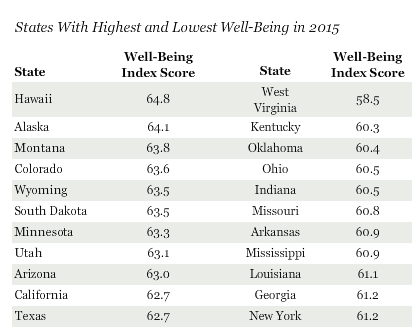Transparency is extremely important to us, so we are letting you know that we may receive a commission on some of links you click on from this page. See our disclaimer.
 Luckily, the U.S. added Hawaii and Alaska as our last two states. Perhaps they can show the rest of us how it's done!
Luckily, the U.S. added Hawaii and Alaska as our last two states. Perhaps they can show the rest of us how it's done!
Gallup released its latest ranking of states' well-being index, and for the fifth time since the list was launched in 2008, Hawaii took the top spot for 2015. Our 50th state pushed the 49th state, Alaska, from the No. 1 position it took in 2014.
According to Gallup, “the Well-Being Index is calculated on a scale of 0 to 100, where 0 represents the lowest possible well-being and 100 represents the highest possible well-being. The Gallup-Healthways Well-Being Index score for the nation and for each state comprises metrics affecting overall well-being and each of the five essential elements of well-being:”
- “Purpose: liking what you do each day and being motivated to achieve your goals”
- “Social: having supportive relationships and love in your life”
- “Financial: managing your economic life to reduce stress and increase security”
- “Community: liking where you live, feeling safe and having pride in your community”
- “Physical: having good health and enough energy to get things done daily”
As one might expect, where you live matters: “As in prior years, well-being in the U.S. shows regional patterns. The northern Plains and Mountain West are higher well-being areas, along with some western states and pockets of the Northeast and Atlantic. The lowest well-being states are in the south and through the industrial Midwest.”
Two tough places to live: West Virginia and Kentucky. This marks the seventh-straight year these two states bring up the bottom on the index.
Some important areas where Americans have been improving focus on behaviors that can be worked on through workplace wellness and other programs. These include a reduction in smoking and an increase in exercise. On the downside, “Obesity in the U.S. has continued its relentless upward climb, reaching a new high mark last year. And the trend may continue as half of all overweight adults say they are not seriously trying to lose weight.”





0 Comments